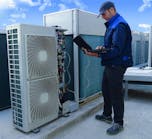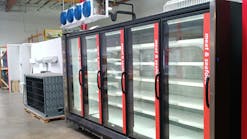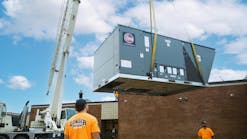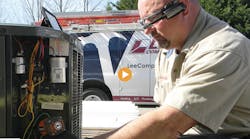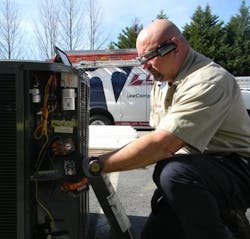When 73-year-old Franklin, Tennessee-based Lee Company wanted to enable growth while also addressing the skilled labor gap, they began looking for technology solutions.
Following a successful pilot program, in January of this year it successfully integrated smart glasses across its commercial and residential divisions. In about six months time, there have been significant results in terms of increased productivity, workforce development and customer satisfaction.
Lee Company — a past ContractingBusiness.com Commercial Contractor of the Year — and many other HVAC firms, is struggling to locate and hire qualified technicians. According to the US Department of Labor, there were 800,000 unfilled skilled trades jobs last year — a number that some predict will rise to 31 million by 2020. The HVAC industry itself is staring at a new labor need of 115,000 by 2020, according to the HVAC Workforce Development Foundation.
There were also inefficiencies within Lee Company’s workflow that leadership wanted to solve, including the amount of system outage time that customers experienced when a junior technician needed support to complete a repair. Improved client communication was needed, by “bringing the customer to the problem” digitally.
As Lee Company’s leadership team discussed these problems, the company began researching ways to use technology to empower growth and improve customer relations despite the technician shortage. In the summer of 2015, Lee Company began piloting XOEye’s wearable technology platform (xoeye.com). Eight months later, more than 300 devices are in use by Lee Company technicians, making it one of the largest roll-outs of wearable technology across an enterprise.
The XOEye team developed workflows and provided training and field support, and their understanding of the HVAC service industry has been incredibly valuable to Lee Company as they integrate the new technology and train their technicians on how to use it. Ongoing support is provided.
With XOEye, Lee Company can handle more service calls, offer better support to field technicians, retain experienced personnel who wanted to retire from the physical demands of onsite work, and provide better customer service. Since implementing XOEye solutions, Lee Company has experienced less down time for their customers and an increase in new business sales, as well as significant cost savings from not having to send a second person to a job site to resolve a problem. Additionally, as news of Lee Co.’s innovative stance in the industry has grown, new employment applications have increased.
Lee Co. has seen $20 ROI per $1 invested in XOEye’s technology (per 100 technicians); $500 saved via telepresence per month per tech average (on things like travel and labor costs), and an average $2,500 incremental sale per month per tech by increasing customer visibility and transparency. They also saw a decrease in the number of calls from customers seeking additional details. For new work, technicians can now talk a customer through what the repair process will be while providing a visual of the work site.
Lee Company is enthusiastic about the benefits and is confident the platform will produce an even greater ROI in the long term.
“Five years ago we were like most companies: we had paper tickets, were dispatching like everybody else, and sent support when somebody got stumped on a job,” said Steve Scott, vice president of Facilities Solutions. “When we’re looking at ways to grow or expand the business, you either need to be more efficient — or you can use technology to close that gap.”
Long term, XOEye’s technology will enable Lee Company to operate efficiently, continue to differentiate themselves by providing increased value to their customers, and to grow the business with technology that allows them to perform more service to more customers in spite of the drastically declining skilled labor availability.
